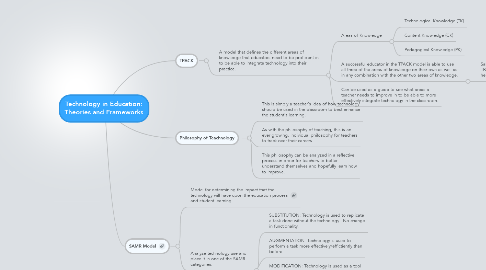
1. SAMR Model
1.1. Model for determining the impact that the technology will have upon the education process and student learning
1.2. Analyze technology use and place it in one of the SAMR categories:
1.2.1. SUBSTITUTION: Technology is used to replicate a task done without the technology. No change in functionality.
1.2.2. AUGMENTATION: Technology is used to perform a task more effectively/effictiently than before.
1.2.3. MODIFICATION: Technology is used as a tool to change the task at hand to make it a more valuable and complete learning experience.
1.2.4. REDEFINITION: Technology is used to complete original tasks that were previously impossible without the technology.
2. TPACK
2.1. A model that defines the different areas of knowledge that educators need to be proficient in to be able to integrate technology into their practice.
2.1.1. Areas of Knowledge
2.1.1.1. Technological Knowledge (TK)
2.1.1.2. Content Knowledge (CK)
2.1.1.3. Pedagogical Knowledge (PK)
2.1.2. A successful educator in the TPACK model is able to use all three of the areas of knowledge on their own as well as in any combination with the other two areas of knowledge.
2.1.2.1. Sample Venn Diagram of the TPACK model can be found here.
2.1.3. Can be used as a guide to see what areas a teacher needs to improve in to be able to more effectively integrate technology in the classroom.
